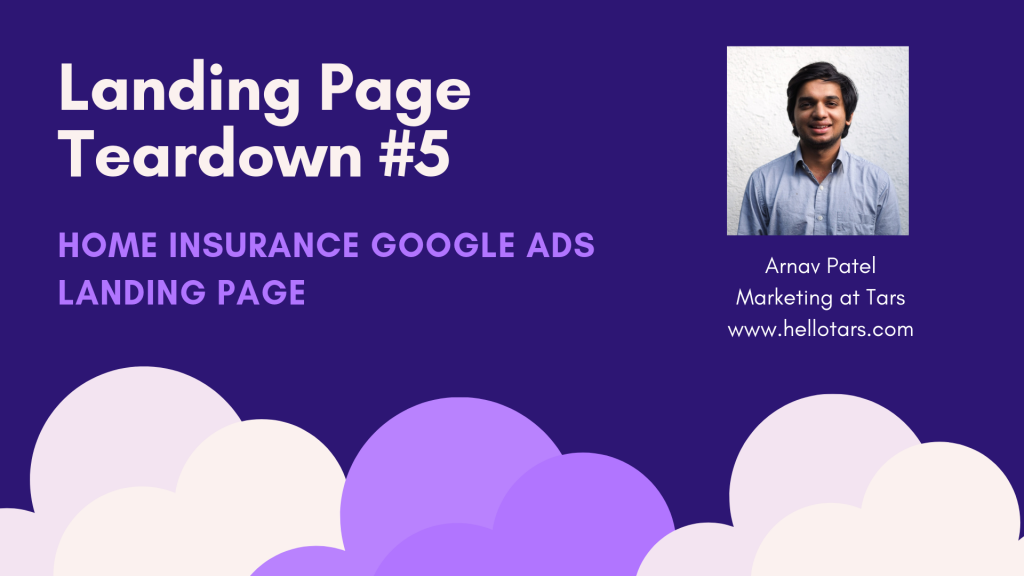[Landing Page Teardown] Improving the Home Insurance Buyer Journey

The home insurance market is massive. 85% of all homes in the US are insured and home insurers made a total of 104 billion dollars in revenue. How do they achieve such a massive scale? By running unparalleled marketing campaigns that blitz prospects with their brand name transforming themselves into household names. Ask the average American and they will know GEICO’s gecko, Flo from Progressive or the Nationwide jingle. This week, we took a look at how these massive businesses generate leads at scale through their notoriously expensive Google Ads Campaigns and suggest ways in which they can improve their landing page conversion rate.
Background Information
The companies in this space are household names
With most of the other industries we’ve looked at so far in this teardown series, the companies that have been running ads have been relatively SMBs with relatively local presences or larger companies focused on relatively small markets. None have been the sort of companies that run national superbowl commercials. Homeowners Insurance is different. All of the companies are big household names that most people have heard of. Names like Geico, AllState and Progressive show up.
Branded keywords are important
A lot of keywords that companies are bidding on in this space are branded keywords. For the uninitiated, a branded keyword contains a company name in it like “GEICO home insurance.” Considering the previous point about widespread brand recognition for the advertisers in this space, this makes sense. The constant advertising blitz of insurance commercials that most prospects are subject to means that a lot of them will associate homeowner’s insurance with a particular brand name.
High AdSpend
$10-$50 is reasonably high CPC but it’s not the highest we’ve seen (Accident Lawyers paid upwards of $200 per click). But, if you combine this CPC with the 100k+ search volume of terms in this space it makes for an industry with insanely high adspend.
The Landing Page
I looked up “home insurance” and unsurprisingly the first 4 links were ads
I clicked on the Geico link because I LOVE their ads and this is the landing page that came up:
Check it out HERE
Unlike previous teardowns where I’ve pointed out several issues with the landing page, I am going to focus on two issues with this page because there really isn’t much on this page to critique. Literally, there is almost nothing on this page.
The first has to do with the experience after you submit your zipcode. It’s a particularly ugly looking form, which is going to cause a lot of people to drop. A conversational landing page or even a typeform-esque
The second, more significant issue with this page its sparseness. At the outset, I’d like to point out that I am not opposed to minimalist landing pages. In fact, if you take a look at some of the previous teardowns, I caution marketers against having too much content on their pages. That said, this page just looks weird to me.
The first time I landed on the page, I waited 5 minutes for something more to load and refreshed a few times to double check that the landing page was in fact as sparse as it was.
In all fairness to GEICO, once I figured out that there was nothing form that asks for one field at a time won’t inundate prospects with an overload of information else to the page, it was extremely evident what I had to do get a quote. Either give my zip code or call their number. The lack of other CTAs and content means that a prospect has no distractions from the actual lead generation process.
The issue is that GEICO’s hasn’t executed it well.
Most prospects are accustomed to seeing landing pages that are information-rich. They usually have a menu at the top, they have images on them, maybe some friendly looking icons. When companies choose to strip most of these elements off their pages, they usually reorient the them so that there is an even distribution of elements across the page. They also tend to use visual elements to substitute for the lack of text. Take a look at the progressive landing page as an example. It’s also pretty minimalist but it looks far more engaging than the GEICO one because they’ve put a smiling picture of Flo on the page:
In GEICO’s case however, they haven’t done any of this. The page just looks odd. It looks like they took a regular landing page and removed all the elements not essential to the lead gen process and left a bunch of jarring white space and a complete lack of personality (as a fan of the GEICO gecko I kinda wish they added a bit of their characteristic GEICO humor in the page)
These might seem like cosmetic issues, but in my experience prospects can be irrational and fickle and often will close out of a landing page if it looks weird in a bad way. Speaking from personal experience, if a webpage doesn’t feel complete I feel annoyed at best and close the page at worst.
The Solution
Conversational landing pages aren’t always the solution, but in this case, it most certainly is. Here is the conversational landing page I created to replace the GEICO one (Check it out here):
The beauty of the chat interface is that you can strip away all the information from the page and it doesn’t look weird. When people see chat bubbles on a screen they expect them to be short because chat as a medium is oriented towards short pieces of text. The inherent properties of the interface mean that text is restricted from certain parts of the screen. The white space next to each bubble is something people expect because that is what they are conditioned to expect from a chat interface.
In other words, a conversational landing page is a non-traditional landing page design that is geared towards the minimalism that GEICO is striving towards in this landing page.
Conclusion
The takeaway from this teardown is a simple one. If you want to create a distraction-free lead gen experience you need to do it in a way that doesn’t feel impersonal and jarring. In practice, this means that when you create a landing page with little text on it, you need to be careful about how you use white space. Too much white space on a traditional landing page can make hte UX feel off-putting and cause your conversion rate to fall. To avoid this, marketers can either pay close attention to how they distribute elements across the page and add visuals to make up for the text, or they can use a conversational landing page.
Arnav is the Director of Content Marketing at Tars. He spends most days building bots, writing about conversational design and scrolling through Giphy’s trending section looking for the gifs that go into the Tars Newsletter.
Recommended Reading: Check Out Our Favorite Blog Posts!

Top 10 Use Cases of Generative AI in Claims Management

Top 10 Digital transformation Trends in the Insurance Industry

What is InsurTech and How It Drives Digital Transformation in Insurance

Our journey in a few numbers
With Tars you can build Conversational AI Agents that truly understand your needs and create intelligent conversations.
years in the conversational AI space
global brands have worked with us
customer conversations automated
countries with deployed AI Agents




